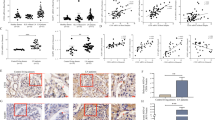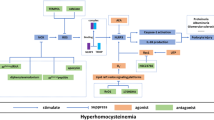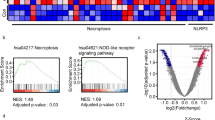Abstract
To explore the role of Notch1 pathway in the pathogenesis of podocyte injury, and to provide novel strategy for podocyte repair in lupus nephritis (LN). Bioinformatics analysis and immunofluorescence assay were applied to determine the expression and localization of Notch1 intracellular domain1 (NICD1) in kidneys of LN patients and MRL/lpr mice. The stable podocyte injury model in vitro was established by puromycin aminonucleoside (PAN) treatment. Expression of inflammasome activation related gene was detected by qPCR. The podocytes with PAN treatment were cultured with or without N-S-phenyl-glycine-t-butylester (DAPT), an inhibitor of Notch1 pathway. NICD1, Wilm’stumor1 (WT1), nucleotide-binding oligomerization domain-like receptors 3 (NLRP3), and absent in melanoma-like receptors 2 (AIM2) were detected by western blot. In vivo, MRL/lpr mice were administrated with DAPT or vehicle. The LN symptoms were assessed. The podocyte injury was evaluated, and the NLRP3 in podocytes of mice was detected. Notch1 pathway was overactivated in glomeruli of LN patients. NICD1 was colocalized with podocytes of LN patients and MRL/lpr mice. The inflammasome-related genes were significantly increased in podocytes with PAN treatment. NICD1 and NLRP3 were significantly decreased, while WT1 was significantly increased in injured podocytes treated with DAPT in vitro. In vivo, lupus-like symptoms were alleviated in DAPT treatment group. Notch1 pathway was inhibited in kidneys of mice treated with DAPT. The renal inflammation was reduced and the podocyte injury was mitigated in DAPT treatment group. The NLRP3 was decreased in podocytes of mice treated with DAPT. Notch1 pathway was overactivated in podocytes of LN patients and MRL/lpr mice. Blockade of Notch1 pathway reduced renal inflammation and alleviated podocyte injury via inhibition of NLRP3 inflammasome activation in LN.






Similar content being viewed by others
References
Tsokos, G.C. 2011. Systemic lupus erythematosus. New England Journal of Medicine 365: 2110–2121. https://doi.org/10.1056/NEJMra1100359.
Yu, C., P. Li, X. Dang, et al. 2022. Lupus nephritis: New progress in diagnosis and treatment. Journal of Autoimmunity 132: 102871. https://doi.org/10.1016/j.jaut.2022.102871.
Blaine, J., and J. Dylewski. 2020. Regulation of the actin cytoskeleton in Podocytes. Cells 9. https://doi.org/10.3390/cells9071700.
Kriz, W. 2002. Podocyte is the major culprit accounting for the progression of chronic renal disease. Microscopy Research and Technique 57: 189–195. https://doi.org/10.1002/jemt.10072.
Rezende, G.M., V.S. Viana, D.M.A.C. Malheiros, et al. 2014. Podocyte injury in pure membranous and proliferative lupus nephritis: Distinct underlying mechanisms of proteinuria? Lupus 23: 255–262. https://doi.org/10.1177/0961203313517152.
Kimura, J., O. Ichii, S. Otsuka, et al. 2013. Close relations between podocyte injuries and membranous proliferative glomerulonephritis in autoimmune murine models. American Journal of Nephrology 38: 27–38. https://doi.org/10.1159/000353093.
Zhou, L., Y. Li, W. He, et al. 2015. Mutual antagonism of Wilms' tumor 1 and β-catenin dictates podocyte health and disease. Journal of the American Society of Nephrology : JASN 26: 677–691. https://doi.org/10.1681/asn.2013101067.
Zhang, C., K.M. Boini, M. Xia, et al. 2012. Activation of Nod-like receptor protein 3 inflammasomes turns on podocyte injury and glomerular sclerosis in hyperhomocysteinemia. Hypertension (Dallas, Tex. : 1979) 60: 154–162. https://doi.org/10.1161/HYPERTENSIONAHA.111.189688.
Rathinam, V.A., and K.A. Fitzgerald. 2016. Inflammasome complexes: Emerging mechanisms and effector functions. Cell 165: 792–800. https://doi.org/10.1016/j.cell.2016.03.046.
Cellesi, F., M. Li, and M.P. Rastaldi. 2015. Podocyte injury and repair mechanisms. Current Opinion in Nephrology and Hypertension 24: 239–244. https://doi.org/10.1097/mnh.0000000000000124.
Shang, Y., S. Smith, and X. Hu. 2016. Role of notch signaling in regulating innate immunity and inflammation in health and disease. Protein & Cell 7: 159–174. https://doi.org/10.1007/s13238-016-0250-0.
Zhou, B., W. Lin, Y. Long, et al. 2022. Notch signaling pathway: Architecture, disease, and therapeutics. Signal Transduction and Targeted Therapy 7: 95. https://doi.org/10.1038/s41392-022-00934-y.
Cheng, H.-T., and R. Kopan. 2005. The role of notch signaling in specification of podocyte and proximal tubules within the developing mouse kidney. Kidney International 68: 1951–1952.
Vooijs, M., C.-T. Ong, B. Hadland, et al. 2007. Mapping the consequence of Notch1 proteolysis in vivo with NIP-CRE. Development 134: 535–544. https://doi.org/10.1242/dev.02733.
Waters, A.M., M.Y.J. Wu, T. Onay, et al. 2008. Ectopic notch activation in developing podocytes causes glomerulosclerosis. Journal of the American Society of Nephrology : JASN 19: 1139–1157. https://doi.org/10.1681/ASN.2007050596.
Liu, M., K. Liang, J. Zhen, et al. 2017. Sirt6 deficiency exacerbates podocyte injury and proteinuria through targeting notch signaling. Nature Communications 8: 413. https://doi.org/10.1038/s41467-017-00498-4.
Guo, A., Y. Sun, X. Xu, et al. 2022. MicroRNA-30a targets Notch1 to alleviate Podocyte injury in lupus nephritis. Immunological Investigations 51: 1694–1706. https://doi.org/10.1080/08820139.2022.2027440.
Li, L.S., and Z.H. Liu. 2004. Epidemiologic data of renal diseases from a single unit in China: Analysis based on 13,519 renal biopsies. Kidney International 66: 920–923. https://doi.org/10.1111/j.1523-1755.2004.00837.x.
Quillard, T., and B. Charreau. 2013. Impact of notch signaling on inflammatory responses in cardiovascular disorders. International Journal of Molecular Sciences 14: 6863–6888. https://doi.org/10.3390/ijms14046863.
Outtz, H.H., J.K. Wu, X. Wang, et al. 2010. Notch1 deficiency results in decreased inflammation during wound healing and regulates vascular endothelial growth factor receptor-1 and inflammatory cytokine expression in macrophages. Journal of Immunology 185: 4363–4373. https://doi.org/10.4049/jimmunol.1000720.
Jin, Y., C. Li, D. Xu, et al. 2020. Jagged1-mediated myeloid Notch1 signaling activates HSF1/snail and controls NLRP3 inflammasome activation in liver inflammatory injury. Cellular & Molecular Immunology 17: 1245–1256. https://doi.org/10.1038/s41423-019-0318-x.
Lee, S., S.K. Kim, H. Park, et al. 2020. Contribution of autophagy-Notch1-mediated NLRP3 Inflammasome activation to chronic inflammation and fibrosis in keloid fibroblasts. International Journal of Molecular Sciences 21. https://doi.org/10.3390/ijms21218050.
Hochberg, M.C. 1997. Updating the American College of Rheumatology revised criteria for the classification of systemic lupus erythematosus. Arthritis and Rheumatism 40: 1725. https://doi.org/10.1002/art.1780400928.
Bajema, I.M., S. Wilhelmus, C.E. Alpers, et al. 2018. Revision of the International Society of Nephrology/Renal Pathology Society classification for lupus nephritis: Clarification of definitions, and modified National Institutes of Health activity and chronicity indices. Kidney International 93: 789–796. https://doi.org/10.1016/j.kint.2017.11.023.
Andrews, B.S., R.A. Eisenberg, A.N. Theofilopoulos, et al. 1978. Spontaneous murine lupus-like syndromes. Clinical and immunopathological manifestations in several strains. The Journal of Experimental Medicine 148: 1198–1215. https://doi.org/10.1084/jem.148.5.1198.
Ran, Y., F. Hossain, A. Pannuti, et al. 2017. γ-Secretase inhibitors in cancer clinical trials are pharmacologically and functionally distinct. EMBO Molecular Medicine 9: 950–966. https://doi.org/10.15252/emmm.201607265.
Teachey, D.T., A.E. Seif, V.I. Brown, et al. 2008. Targeting notch signaling in autoimmune and lymphoproliferative disease. Blood 111: 705–714. https://doi.org/10.1182/blood-2007-05-087353.
Zhang, W., W. Xu, and S. Xiong. 2010. Blockade of Notch1 signaling alleviates murine lupus via blunting macrophage activation and M2b polarization. Journal of Immunology 184: 6465–6478. https://doi.org/10.4049/jimmunol.0904016.
Jiao, Z., W. Wang, S. Hua, et al. 2014. Blockade of notch signaling ameliorates murine collagen-induced arthritis via suppressing Th1 and Th17 cell responses. The American Journal of Pathology 184: 1085–1093. https://doi.org/10.1016/j.ajpath.2013.12.010.
Galvao, J., B. Davis, M. Tilley, et al. 2014. Unexpected low-dose toxicity of the universal solvent DMSO. The FASEB Journal 28: 1317–1330. https://doi.org/10.1096/fj.13-235440.
Caren, L.D., H.M. Oven, and A.D. Mandel. 1985. Dimethyl sulfoxide: Lack of suppression of the humoral immune response in mice. Toxicology Letters 26: 193–197. https://doi.org/10.1016/0378-4274(85)90166-3.
Morton, J.I., B.V. Siegel, W.J. Weaver, et al. 1983. The effects of chronic DMSO administration on the spontaneous development of autoimmune disease in NZB, BXSB, and MRL/lpr strain mice. Annals of the New York Academy of Sciences 411: 344–346. https://doi.org/10.1111/j.1749-6632.1983.tb47321.x.
Zhang, Z., L. Niu, X. Tang, et al. 2019. Mesenchymal stem cells prevent podocyte injury in lupus-prone B6.MRL-Faslpr mice via polarizing macrophage into an anti-inflammatory phenotype. Nephrology, Dialysis, Transplantation 34: 597–605. https://doi.org/10.1093/ndt/gfy195.
Inokuchi, S., I. Shirato, N. Kobayashi, et al. 1996. Re-evaluation of foot process effacement in acute puromycin aminonucleoside nephrosis. Kidney International 50: 1278–1287. https://doi.org/10.1038/ki.1996.439.
Nishad, R., D. Mukhi, S.V. Tahaseen, et al. 2019. Growth hormone induces Notch1 signaling in podocytes and contributes to proteinuria in diabetic nephropathy. The Journal of Biological Chemistry 294: 16109–16122. https://doi.org/10.1074/jbc.RA119.008966.
Tao, X., F. Fan, V. Hoffmann, et al. 2006. Therapeutic impact of the ethyl acetate extract of Tripterygium wilfordii hook F on nephritis in NZB/W F1 mice. Arthritis Research & Therapy 8: R24. https://doi.org/10.1186/ar1879.
Fu, Y., Y. Sun, M. Wang, et al. 2020. Elevation of JAML promotes diabetic kidney disease by modulating Podocyte lipid metabolism. Cell Metabolism 32: 1052–1062.e1058. https://doi.org/10.1016/j.cmet.2020.10.019.
Djudjaj, S., C. Chatziantoniou, U. Raffetseder, et al. 2012. Notch-3 receptor activation drives inflammation and fibrosis following tubulointerstitial kidney injury. The Journal of Pathology 228: 286–299. https://doi.org/10.1002/path.4076.
Bielesz, B., Y. Sirin, H. Si, et al. 2010. Epithelial notch signaling regulates interstitial fibrosis development in the kidneys of mice and humans. The Journal of Clinical Investigation 120: 4040–4054. https://doi.org/10.1172/jci43025.
Niranjan, T., B. Bielesz, A. Gruenwald, et al. 2008. The notch pathway in podocytes plays a role in the development of glomerular disease. Nature Medicine 14: 290–298. https://doi.org/10.1038/nm1731.
Yang, M., D. Long, L. Hu, et al. 2021. AIM2 deficiency in B cells ameliorates systemic lupus erythematosus by regulating Blimp-1-Bcl-6 axis-mediated B-cell differentiation. Signal Transduction and Targeted Therapy 6: 341. https://doi.org/10.1038/s41392-021-00725-x.
Wu, Y., J. Luan, C. Jiao, et al. 2021. circHIPK3 exacerbates folic acid-induced renal Tubulointerstitial fibrosis by sponging miR-30a. Frontiers in Physiology 12: 715567. https://doi.org/10.3389/fphys.2021.715567.
Bai, T., X. Wang, C. Qin, et al. 2022. Deficiency of mindin reduces renal injury after ischemia reperfusion. Molecular Medicine (Cambridge, Mass.) 28: 152. https://doi.org/10.1186/s10020-022-00578-2.
Tanase, D.M., E.M. Gosav, S. Radu, et al. 2019. The predictive role of the biomarker kidney Molecule-1 (KIM-1) in acute kidney injury (AKI) cisplatin-induced nephrotoxicity. International Journal of Molecular Sciences 20. https://doi.org/10.3390/ijms20205238.
Baraldi, A., G. Zambruno, L. Furci, et al. 1994. Beta-1 integrins in the normal human glomerular capillary wall: An immunoelectron microscopy study. Nephron 66: 295–301. https://doi.org/10.1159/000187826.
Li, M.R., C.T. Lei, H. Tang, et al. 2022. MAD2B promotes podocyte injury through regulating numb-dependent notch 1 pathway in diabetic nephropathy. International Journal of Biological Sciences 18: 1896–1911. https://doi.org/10.7150/ijbs.68977.
Dou, Y., Y. Shang, Y. Shen, et al. 2020. Baicalin alleviates adriamycin-induced focal segmental glomerulosclerosis and proteinuria by inhibiting the Notch1-snail axis mediated podocyte EMT. Life Sciences 257: 118010. https://doi.org/10.1016/j.lfs.2020.118010.
von Spee-Mayer, C., E. Siegert, D. Abdirama, et al. 2016. Low-dose interleukin-2 selectively corrects regulatory T cell defects in patients with systemic lupus erythematosus. Annals of the Rheumatic Diseases 75: 1407–1415. https://doi.org/10.1136/annrheumdis-2015-207776.
Shao, M., J. He, R. Zhang, et al. 2019. Interleukin-2 deficiency associated with renal impairment in systemic lupus erythematosus. Journal of Interferon & Cytokine Research 39: 117–124. https://doi.org/10.1089/jir.2018.0016.
Acknowledgements
We thank Dr. Jiaheng Xie, for his kind suggestion in the revision of the manuscript.
Funding
This work was supported by the National Key R&D Program of China (2020YFA0710800), the Key Program of National Natural Science Foundation of China (81930043), the Jiangsu Provincial Key Research and Development Program (BE2020621) and the National Science Foundation of Jiangsu Province (BK20210016).
Author information
Authors and Affiliations
Contributions
All authors contributed to the study conception and design. WD, YGH and SLY designed experiments. WD and JTT carried out experiments. Data collection and analysis were performed by WD, ZSY, HMX, ZY and CL. The first draft of the manuscript was written by WD. All authors commented on previous versions of the manuscript. ZYY, ZDD and YHH performed the language modifying. All authors read and approved the final manuscript.
Corresponding authors
Ethics declarations
Ethics Approval
This study was performed in line with the principles of the Declaration of Helsinki, and approved by the Ethics Committee of Nanjing Drum Tower Hospital. This study followed the NIH Guide for the Care and Use of Laboratory Animals. All animal experimental protocols were approved by the Ethics Committee of Nanjing Drum Tower Hospital.
Consent to Participate
Written informed consent was obtained from the parents.
Competing Interest
The authors declare no competing interests.
Additional information
Publisher’s Note
Springer Nature remains neutral with regard to jurisdictional claims in published maps and institutional affiliations.
Supplementary Information
ESM 1
(DOCX 271 kb)
Rights and permissions
Springer Nature or its licensor (e.g. a society or other partner) holds exclusive rights to this article under a publishing agreement with the author(s) or other rightsholder(s); author self-archiving of the accepted manuscript version of this article is solely governed by the terms of such publishing agreement and applicable law.
About this article
Cite this article
Wu, D., Jiang, T., Zhang, S. et al. Blockade of Notch1 Signaling Alleviated Podocyte Injury in Lupus Nephritis Via Inhibition of NLRP3 Inflammasome Activation. Inflammation 47, 649–663 (2024). https://doi.org/10.1007/s10753-023-01935-x
Received:
Revised:
Accepted:
Published:
Issue Date:
DOI: https://doi.org/10.1007/s10753-023-01935-x




